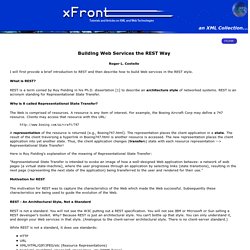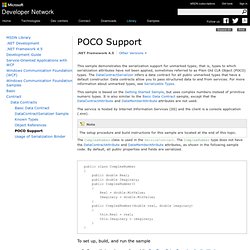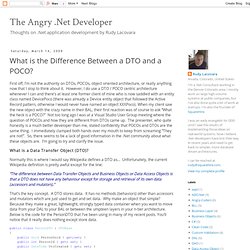

Www.xfront.com/REST-Web-Services.html. I will first provide a brief introduction to REST and then describe how to build Web services in the REST style.

What is REST? REST is a term coined by Roy Fielding in his Ph.D. dissertation [1] to describe an architecture style of networked systems. REST is an acronym standing for Representational State Transfer. Getting Started Tutorial. The topics contained in this section are intended to give you quick exposure to the Windows Communication Foundation (WCF) programming experience.

They are designed to be completed in the order of the list at the bottom of this topic. Working through this tutorial gives you an introductory understanding of the steps required to create WCF service and client applications. A service exposes one or more endpoints, each of which exposes one or more service operations. The endpoint of a service specifies an address where the service can be found, a binding that contains the information that describes how a client must communicate with the service, and a contract that defines the functionality provided by the service to its clients. All of the topics in this section assume you are using Visual Studio 2011 as the development environment.
Data Transfer Object. Version 1.0.1 GotDotNet community for collaboration on this pattern Complete List of patterns & practices Context You are designing a distributed application, and to satisfy a single client request, you find yourself making multiple calls to a remote interface, which increases the response time beyond acceptable levels.

Problem How do you preserve the simple semantics of a procedure call interface without being subject to the latency issues inherent in remote communication? Forces. A RESTful Web service, an example. It's often hard for people to "get" REST, this is mostly due to the fact that REST isn't a tangible thing like a piece of software or even a specification, it's a selection of ideals, of best practices distilled from the HTTP specs.

I've always found that the best way to understand something is to see an example, to see the principles in action first and worry about the details later once I understand the general gist. So here's a little example of a RESTful version of a simple Web service you might already know about, the Delicious API. Delicious has “a simple REST API”, or rather, a simple POX over HTTP API, that is, it has a perfectly usable HTTP and XML based API for accessing your bookmarks and tags, but it isn't very RESTful. Why not? First class objects aren't exposed as resources, so we can't access our bookmarks or tags directly. So (ignoring why) how can we make it better, make it more RESTful? How to define global variable in C# - C# C# - what is Entity Framework with POCO. PhoneBookService Service. POCO Support. The service is hosted by Internet Information Services (IIS) and the client is a console application (.exe). public class ComplexNumber { public double Real; public double Imaginary; public ComplexNumber() { Real = double.MinValue; Imaginary = double.MinValue; } public ComplexNumber(double real, double imaginary) { this.Real = real; this.Imaginary = imaginary; } } To set up, build, and run the sample.

What is the Difference Between a DTO and a POCO? First off, I’m not the authority on DTOs, POCOs, object oriented architecture, or really anything now that I stop to think about it.

However, I do use a DTO / POCO centric architecture whenever I can and there’s at least one former client of mine who is now saddled with an entity class named DevicePoco (there was already a Device entity object that followed the Active Record pattern, otherwise I would never have named an object XXXPoco). When my client saw the new object with the crazy name in their BAL, their first reaction was of course to ask “What the heck is a POCO?” Not too long ago I was at a Visual Studio User Group meeting where the question of POCOs and how they are different from DTOs came up. 5 Minute Introduction to ASP.NET MVC. Plain Old CLR Object. Plain Old CLR Object or POCO is a play on the term POJO, from the Java EE programming world, and is used by developers targeting the Common Language Runtime of the .NET Framework.

Similar to the Java context, the term is used to contrast a simple object with one that is designed to be used with a complicated, special object framework such as an ORM component. Another way to put it is that POCOs are objects unencumbered with inheritance or attributes needed for specific frameworks.[1] In .NET terms, the word is most often used in the programmatic sense, to differentiate a non-Serviced Component (see MTS) from a "standard object". It can also be used in a tongue-in-cheek manner, referencing the perceived complexity and invasiveness of Java-based programming frameworks such as the legacy EJB2. See also[edit] References[edit] Template:Comput-lang-stub. Getting Started Tutorial. Escaping Special Characters < JavaScript. Every programming language has it's special characters - characters that mean something special such as identifying a variable, the end of a line or a break in some data.

JavaScript is no different, so it provides a number of functions that encode and decode special characters. If you're interacting between PHP and JavaScript you will also need to be familiar with the PHP functions for encoding and decoding special characters, which is why we've created this special tool for testing and comparing different functions. 1. Encoding and decoding using JavaScript and PHP The form below let's you see the output of various functions that are used to encode special characters when they appear in plain text or URL parameters (following the '? ' These functions perform replacements on certain characters as shown in the table futher down the page and described briefly here: 2. C# - POCO vs DTO.